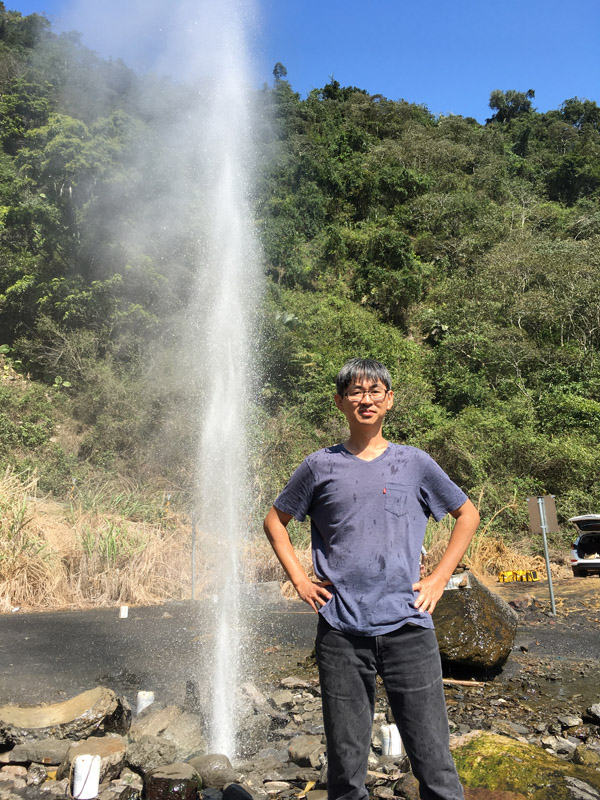28 October 2022–Fan-Chi Lin likes to travel. Some of his favorite destinations are the U.S. national parks, “and I’ve always been curious about how seismology can help us to learn more about the geological features we observe there,” he said.
Now, one of his largest research projects involves one of the most famous national parks and some of its most famous features. Lin, an associate professor of geology and geophysics at the University of Utah, and his colleagues are using ambient seismic noise to learn more about Yellowstone National Park geysers like Steamboat and Old Faithful.
Ambient seismic noise refers to persistent seismic waves caused by human and environmental sources such as the pulse of ocean waves against sea floor and the world’s shorelines or the hum caused by heavy machinery at a subsurface mine. “In general, the Earth is shaking all the time, and what we try to do is figure out the relationship between the ambient noise vibrations detected from different locations and use them to try to figure out the structure of the Earth in between,” Lin explained.
He compared the process to two friends trying to communicate with each other at opposite ends of a noisy room, identifying random but similar sound bites they hear that could tell them something about the space in between them.
Lin was one of the pioneers of using ambient seismic noise in a variety of seismology applications, receiving SSA’s 2015 Charles F. Richter Early Career Award for his original contributions to the field. “The neat thing about using ambient noise is that this is the dataset that traditional seismologists would discard as noise, and now it’s turning out to be a very useful signal,” he said.

Since his Ph.D. thesis in 2009, Lin and others have been expanding the uses of ambient noise, using it to study shallow structures in the crust and upper mantle, the structure of the core, and monitoring the stability of subsurface structures such as volcanoes and underground coal mines, among other applications. The wealth of ambient noise data is exciting, Lin said, especially when some of the data were collected decades ago as part of traditional earthquake recordings. “The amount of data in seismology in general is growing very fast, and everyone is very generous in sharing their data through the community.”
At Yellowstone, Lin and his colleagues are using ambient noise analyses to “better understand the subsurface of geysers and their physical states at different states of eruption, which we hope will lead to better models and possibly even predict their eruptions,” he said.
Among their findings are interesting patterns in the frequencies of hydrothermal tremor at the geysers. For instance, these frequencies differ depending on whether they occur at shallow or deep parts of the geyser conduit. The aim is to connect these patterns with physical processes—for instance, lower frequency tremors deep in the conduit appear to be related to liquids converting gas, and higher frequency tremors at shallower levels represent the collapse of vapor bubbles hitting colder water.
The research may have implications for predicting volcanic activity, Lin noted, although those applications are far down the road.
Among Lin’s other projects is a study using nodal geophones to determine the basin structure around Salt Lake City and the Wasatch Fault, to help better determine the seismic hazard for the region. He and his colleagues have participated in geophone installations in Utah, southern California, Hawaii, Alaska, Yellowstone, and Oregon.
Lin discussed the geophone research at SSA’s Seismic Tomography meeting in Toronto in October. “It’s a good way to densify any particular area we want to study and get a very high-resolution crustal structure,” he said.
Despite growing up in Taiwan and experiencing many large earthquakes, seismology wasn’t Lin’s first choice for a career in the sciences. Even after he received a bachelor’s degree in physics, “I still had really broad interests and I didn’t know exactly what I wanted to study,” he said.
He tried biochemistry, biophysics, astrophysics, and atomic physics before landing on geophysics at the University of Colorado, Boulder. The first years of USArray were under way, and Lin’s advisor Michael Ritzwoller thought the massive amounts of data coming through the program might be a good fit for Lin.
“I feel like I’m very good at looking at data, finding patterns, and making sense of them through math and physics, so I decided to give it a try and have been in love with geophysics ever since,” Lin said.
Someday Lin would like to study the tectonic structure of Taiwan and how it connects with the landscape he remembers. “When I was growing up in Taiwan I was not a geophysicist, I was not even in Earth science, I was focused on learning physics,” he recalled, “and it’s not until I came to the U.S. that I started to learn all this, so I really haven’t had a chance to understand the fascinating landscape I actually grew up with.”
SSA At Work is a monthly column that follows the careers of SSA members. For the full list of issues, head to our At Work page.
